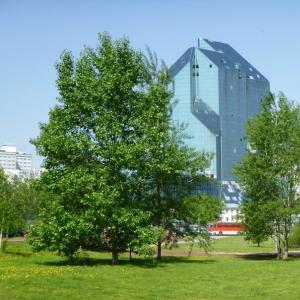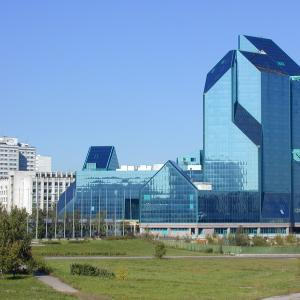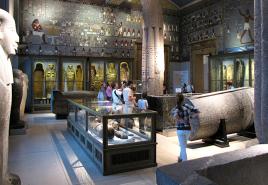City under one roof.
The Elder Scrolls. Hell city
The first of two Elder Scrolls novels by Greg Keyes, The Infernal City: An Elder Scrolls Novel, went on sale November 24, 2009. (Publisher: Del Rey, 2009; paperback, 304 pages; English). In Russian, the book became available to fans of the Elder Scrolls a year later - now "The Elder Scrolls. Infernal City" can be bought, for example, in Ozone (publishing houses: Eksmo, Domino, 2011; hardcover, 400 pages; translator Vladislav Rusanov).
The beginning of the book
Four decades after the Oblivion Crisis, Tamriel is once again in danger, an ancient, all-consuming evil. This is the flying city of Umbriel, casting a terrible shadow - wherever it falls, people die and are reborn as living dead. And here, in the shadow of Umbriel, a wonderful adventure will begin and a strange company will come together, which can hardly be called heroic - the mysterious prince-legend; an agent following a vast conspiracy; a magician obsessed with his revenge; and young Annays, in whose hands the fate of all Tamriel may be decided ...
The reader finds himself in Black Marsh, in the town of Lilmoth, where seventeen-year-old Breton Annaig and her bosom childhood friend, Argonian Light-Eye (Mere-Glim), are involved in another risky adventure (as usual, this is the initiative of the restless Annaig) breeding were-crocodile. With this noble goal in mind, the couple travel to Lilmot's slum, Pusbottom. On the spot, it turns out that in fact there is no werewolf, but there is a deadly lair of skooma merchants, from whose clutches the friends manage to escape only as a result of a successful (this time) alchemical experiment of Annays. More or less smoothly flying off the roof of the building and breaking away from the chase, the friends return to the old villa of Father Annays, which is in the imperial part of Lilmoth, and there begins their intimate conversation, shedding some light on the events of the last four decades ...
State of affairs in the Empire
40 years after the events of Oblivion, the Empire as it was at the end of the 3rd era is no longer there, now only Cyrodiil is undoubtedly present in its composition. There is too little or no information in the book about the situation in High Rock, Hammerfell, Orsinium and Skyrim, so it’s impossible to say for sure whether they are the Imperial provinces as before. It can be assumed that Skyrim is independent and is at enmity with the Empire, since one of the main heroes was threatened to be sent there as a spy as punishment, while Hammerfell may be under the rule of the Empire, since Crown Prince Attrebus Meade was there. For Cyrodiil, Valenwood, Summerset Isles, Elsweyr, Black Marsh, and Morrowind, read the spoilers below:
The Oblivion crisis and the end of the Dragonborn Septim line brought turmoil to Cyrodiil. However, the hitherto unknown Colovian Titus Mede was able to collect and solder some part of the former Empire from the fragments. He began his career as a soldier in the army of mercenaries, then became a general in Colovia, then a king in Cyrodiil and finally an emperor. By his own admission, he captured the Imperial City with a thousand fighters, defeating Eddar Olin's Nords. Titus has a son, Crown Prince Attrebus, who is immensely famous for his brave deeds, as well as a younger brother who does not seem (?) To claim the throne.
The Guild of Mages no longer exists, instead of it there are now two organizations - the College of Whispers and the Synod, the Order of the Blades also disappeared, its place was taken by the Penitus Oculatus, engaged in investigations, espionage and the murder of unwanted yard.
On the territory of Cyrodiil, new cities and settlements appeared, such as Aion (near the Pell Gate), which arose on the site of the opened gate to Oblivion right in the middle of a detachment of soldiers who, despite huge losses, still managed to organize a rebuff from the Daedra, or a free trade town Settlement-by-Water (Water Edge), which grew thanks to the enmity of the counties of Bravil and Leyawiin, since everyone in such a situation needed a peaceful place for trade (later Bravil and Leyawiin became part of the Empire again).
The Altmer conquered Valenwood to reclaim their ancestral lands and re-formed the Aldmeri Dominion. Power belongs to the Thalmor, his intentions are quite clear: the subjugation of all Tamriel and the renewal of the Merithic era. In the early 4th era, the islands were hit by a tsunami, possibly as a consequence of the fall of the Ministry of Truth (see Morrowind).
Elsweyr is in turmoil - the Mane is slain and the Potentate rules. The new governor of Rimmena outlawed the nomadic Khajiit clans, they are not sold moon sugar, and they have no right to approach the city. The Kajits living in the city are supplied with everything they need.
The book confirms the information known from the Guidebooks to the Empire related to the birth of the Cathites, namely, their variety and name are determined by the combination of the Masser and Secunda phases. As the story progresses, we will get acquainted with huge, tall with a good riding horse, saddled cats with yellowish-brown skins covered with stripes of caked blood, as well as their riders, many of whom do not differ much from the first in appearance, except that they wear long spacious shirts and scarves (all the same yellow fur with black small streaks, there are a lot of feline features on their faces).
Those who thought of Elsweyr as an arid, lifeless desert were wrong - on the plain of Enequin, wherever the eye falls, grass turns green. In some places one can see streams framed by palm groves, silver-leafed pyramidal poplars and dense thickets of tamarisk. Closer to Rimmen, the landscape changes - here a stream of seemingly inconceivable dimensions swept, washing away all the loose earth to the rocky base and leaving behind an intricate maze of hollows, narrow gorges and ravines. To the east of the city, the ridges of gentle hills pass into the foothills, overgrown with bushes and stunted oaks, and above the real forests begin.
We will also visit Rimmen itself, the market, where most of the crowd consists of Khajiit, and many of them walk with blank or, on the contrary, half-mad eyes, holding pipes with skooma in their hands. Then, along a wide street, bounded by canals, we come to a palace with golden domes, standing on a stone hill surrounded by trees. Cascades fall from all four sides of the palace, feeding canals, and behind the east one can be seen the uneven roof of the Akaviri temple. We could see and visit a building with similar architecture in Cyrodiil - this is the Temple of the Lord of the Clouds north of Bruma.
As you know, in the city of Vivec there was a celestial body of Oblivion origin, which was falling with great speed, called the Ministry of Truth. By the power of Vivec, it was stopped over the city and has since floated in the air over the temple quarter, considered one of the wonders. However, the speed of the fall of this rock did not go anywhere, the rock simply froze, which meant that sooner or later it would end its fall. Which, in fact, happened after the disappearance of Vivec.
Scientists tried to combat the speed of the Ministry's fall - a certain Vuhon created an Ingenium, with which he kept the Ministry of Truth in the air. But the price was high, because the engineering required a soul to work (in order to keep an open source of communication with Oblivion, or more precisely, with the possessions of the Daedric prince Clavicus Vile, who receives power from stolen souls). In the end, the inzhenium exploded and the liberated force hurled Vuon, along with nearby Sul, into Oblivion. The Ministry collapsed on the city, provoking a volcanic eruption and destroying half of Vvardenfell. This disaster has been called the Red Year. The residents who escaped fled to Solstheim. Argonia took advantage of this situation and attacked Morrowind, taking revenge on the Dunmer for a thousand years of enslavement. As a result of all these events, Vivec was completely destroyed, a gulf with boiling liquid appeared in its place, and Morrowind as a political entity ceased to exist.
Thrown into Oblivion by the force of the explosion of Engineering, Sul remained there for thirty-eight years. At the first moment, he happened to see how someone resembling a person created from primordial darkness in outlines threw a sword into a hole through which the Dunmer fell into the plan of Clavicus Vile. Sul tried to follow the sword, but did not have time. The clot of darkness called itself Umbra ...
Despite the defeat of Mehrunes Dagon in an epic battle with Martin Septim, the Imperial forces were unable to adequately counter the Prince of Destruction hordes that invaded Black Marsh. But the Argonians fought with such fury that the servants of Dagon themselves closed the gates of Oblivion, so long as the lizards no longer climbed into them. As a result, the Argonian group An-Xileel, which gained strength in clashes with the Daedra, achieved the independence of Black Marsh from the considerably weakened Empire and at the same time got hold of the plundering of the estates of wealthy Imperials. Argonia then attacked Morrowind, exhausted by the disaster, determined to take revenge on the Dunmer for previous oppression.
The unification and performance of the Argonians against the Daedra, as well as their subsequent attack on Morrowind, was influenced by the Hist trees, the roots of which, penetrating deep into the rich soil and soft white rocks of Black Marsh, unite, linking all the Saxhlil (self-name of the Argonians). This peculiar cult, which affects all human lizards, is extremely hostile to everything alien. This circumstance determined further events - the Hist disowned the Lukaiul (who obeyed the Empire or the corrupted Argonians), thereby deliberately throwing them to death, and Umbriel, flying over Black Marsh, left a deserted area behind him. Of all the Argonians, only the savages and An-Zailil survived.
Book review
Despite the shortcomings present, the book still left a good impression, in any case it is read in one breath. Greg Keys managed to convey the gaming atmosphere quite well, it is immediately clear that he spent a lot of time playing the game and on the site of the Imperial Library. Although the latter may turn out to be a disadvantage for those who decide to read the novel without knowing anything about the universe of the Elder Scrolls, a lot will seem incomprehensible to such a reader (and even the glossary at the end is unlikely to help in this case). It is somewhat disappointing that the narrative ends at the most interesting place, but you have to wait for the release Lord of Souls: An Elder Scrolls Novel :)
If you are interested in this book, then it can be purchased in Russian in Ozone.
The Elder Scrolls. Hellish city - description and summary, author Keys Gregory, read for free online on the electronic library website
For forty years now, the states and peoples of Tamriel have been recovering from the unprecedented destruction caused by the invasion of the armies of the deirdre princes from Oblivion. Emperor Titus Meade is collecting the war-torn lands. Suddenly, a flying island appears off the coast of the continent, destroying all life in its path.
Few dare to confront him and save the world. Among them is Prince Attrebus Meade, whose name is shrouded in romantic legends. Dunmer Sul, a wizard and warrior seeking a longtime enemy. Detective Colin, who pulled the thread of the most dangerous conspiracy. A young girl named Annaig, whose ability for alchemy was appreciated even by the inhabitants of the Infernal City - Umbriel.
Greg Keys is a very famous and talented fantasy writer. His books have won millions of readers' hearts and entered the list of world bestsellers. The novel "Hell City" is based on the universe of the super popular computer RPG "The Elder Scrolls".
Greg Keyes's Infernal City may well serve as an example of how NOT to write game novelizations.
Not only is the book completely lacking in the original atmosphere. In itself, this fact could easily be forgiven, especially since the lack of spirit of the first parts was observed even in Oblivion, and it is impossible to get completely lost on the pages of Infernal City. Keyes quite competently inscribed new realities into the existing world, within the framework of the mythology of the game, he explained the origin of that very hellish city, and he just regularly mentions names, races and locations familiar from travels in Tamriel.
But the fact that "Hellish City" lacks serious conflicts, real villains, exciting action and at least some excitement for the characters is much more difficult to forgive. Perhaps the main drawback of the novel itself is the fact that two books were indicated in the contract of Greg Keyes with the publisher and the studio that developed the game. And instead of writing essentially two books, Keyes decided to write one, split into two parts. With all the ensuing consequences, such as the small volume of the novel, its incompleteness and ending in mid-sentence.
Based on the overall incompleteness of the book, it is difficult to judge the overall contribution of all the storylines to the overall result, but one of the storylines, Colin's line, looks frankly superfluous. The author pays too little attention to her, this thread almost does not intersect with the others, and although Colin himself turned out to be a rather nice guy, and his investigation adds a number of details to the overall picture of events, no one would lose anything from the absence of this storyline.
Other storylines have been worked out by the author in more detail. Keyes has created good and memorable characters, but they cannot really empathize with them. It is immediately evident that the author has far-reaching plans for each hero, and until the very end of the second volume they are not in danger. And there are no serious threats as such in the book. For most of the story, one heroine deals with the costs of a successful chef's life in the kitchen, deals with competitors, unwanted fans and her own talents, and the second is faced with the fact that his rose-colored glasses are smashed in the most cruel way. However, Keyes does not allow his hero to seriously think about his own fate, because at the speed of light he takes the heroes to the finale of the narrative, where ...
Spoiler (plot disclosure)
Nothing happens. The book breaks off mid-sentence, leaving readers and characters in the dark about the future course of events.
It is unlikely that the novel will interest anyone other than fans of the series, and they will not lose anything by postponing the reading of "Infernal City" until the time of writing the second part. And to while away the time in anticipation of "Skyrim", you can reinstall "Morrowind" or "Oblivion". Hail, imperial brothers!
Score: 6
We have to admit: the trend of the transition of game universes into new book series is gaining momentum. Many have already done this. The next step is ZeniMax, Bethesda and their universe the Elder Scrolls, entrusted to the well-known foreign writer Greg Keys.
On the territory of this vast world, there are many places where something could have happened. Take any game, even the most recent release of Oblivion, which takes place in Cyrodiil. The hero can be sent along the Golden Road to Skingrad, or sent on a long journey by water to Topal Bay. Why waste time on trifles? To the north of the imperial city, to the Gerall mountains, Bruma, closer to the location of the new part of the game - Skyrim. But Keyes sends us to the flying island. Fans of the series will say, “Why is this? Wasn't it possible to take advantage of the atmosphere of more famous places? " Yes, and I have already singled out a lot of such reviews, including among those who have read the book in the original language. And they will be right. But this is the meaning of the book - to get acquainted with a new, different from others, history.
From the annotation it was possible to find out that the four main characters are completely different characters. Therefore, events with them do not occur together, but separately. They are intertwined, but not tied into a tight knot. In the first place, you can put two characters, Annays and Light-Eyes, who literally study this island that has flown in from the inside at their own peril and risk. The first gets to work as a cook, and the second - in the Cloaca of the Essence, a place that cannot be described. If you now have any thoughts after reading the phrase "essence cesspool", then you can keep them with you. Here this place can be considered one of the most important in the whole world! I'll leave the details to the readers.
Finally, I would like to note that such books can be recommended even to those who are absolutely not familiar with the game. You will not lose anything, you may even get an interesting book. Well, for those who do not understand everything in the book, at the end there is a very convenient glossary with all the basic concepts.
We are still waiting for the second volume promised by the game publishers. We cannot say that "with impatience", but "with interest" for sure.
Score: 8
I have not experienced such disappointment from reading for a long time. The author has not 100% played the game. Talking to the developers is one thing, but playing ... In short, I made a mess of misunderstanding, the ending is indistinct, ala "touched on the sequel" in The Elder Scrolls V. Where has the incomparable atmosphere of Oblivion and Morra gone? And all this despite the fact that the world and game realities are spelled out in sufficient detail.
The plot is quite decent, but the author's task was not to concoct an entertaining fantasy, but to create a literary embodiment of Tamriel. Here he clearly failed to cope with his task. As for the heroes, things are not so bad here, Keyes has created quite interesting characters, each of whom could appear in any part of The Elder Scrolls. The author's style is quite simple, which also does not speak in favor of the book, but it is easy to read, which makes it interesting for those who want to keep themselves occupied for an hour or two and immediately forget what they have read.
In general, the impressions are very contradictory. Fans of The Elder Scrolls will likely be disappointed, but if you don't view Infernal City through the lens of the game, you can find something interesting for yourself.
Spoiler (plot disclosure) (click on it to see)
And, damn it, poor Dunmer, why?
Score: 7
Curious, who set such a task for him?
In my opinion, the fact that the book will be able to read and understand what is at stake, not only those who played TES, but also "ordinary people", is an undoubted advantage. The book cannot be addressed to a narrow group of fans of a computer game. The book is not an addon.
The plot of "Infernal City" is tailored and tightly stitched. All the hooks catch on when necessary, all the guns are firing, no pianos in the bushes and no gods from the car have yet been found. The incompleteness of the finale is understandable. This is half of the book. It's just that publishers are publishing this way now, without waiting for the final completion.
Score: 8
For those "book lovers" who do not know, I will explain. Gregory Keys is the primary storyteller for The Elder Scrolls and knows exactly what to write. The book is completely imbued with the atmosphere that can be seen in the Bethesda series of games. My mark is 10 points
Score: 10
Personally, I don't trust this Keese. Write about some Hell city. This is nonsense. Tamriel must be torn apart by disputes and strife, since the emperor is not and will not be for a long time. And what kind of flying city? It really spoils the atmosphere.
Rating: 1
After the claimed cool reception among critics, I expected something formulaic and dull, like "TES for dummies." And therefore I was VERY pleasantly surprised to read an exciting and non-standard novel, full of both references and interesting innovations.
Where to start ... First of all, of course, a wonderful walk through Tamriel, especially in the territory of Argonia and Elsweyr, which are very poorly described in the in-game literature. This includes both sociopolitical cuisine and purely geographical touches.
Secondly, the author's ability to skillfully manipulate such universal concepts as duty, family, thirst for change and thrill, which makes him feel sympathy for all the main characters in a fairly short time (and there are five of them in this, I note, a short novel).
The same can be said for races. People are proud and sometimes even arrogant, but they are not alien to compassion and are driven by an infectious spirit of adventure, while the Argonians are cynical and brutal, but not devoid of irony and cheerfulness. The author truncated the essence laid down by the authors of the game lore, carefully and lovingly transferring it into the book.
I also liked the description of Umbriel, who at first appears to the reader and the characters as mysterious and unknown, but on the way opens its doors and secrets, which reminded me personally of the works, oddly enough, by Stanislav Lem, such as Eden.
The story seems linear at first, but Mr. Keyes continues to add more characters and new locations, which has two sides. On the one hand, the novel is simply replete with fascinating events (just one race according to Oblivion's plans is worth something) and interesting personalities (in general, everyone, extras and villains on duty are simply absent here). But on the other hand, this led to a dangling ending and in some places too frequent jumps between storylines (especially towards the end).
Of course, there were some drawbacks, but, fortunately, only in minor details. The author's Argonians swim "rowing with hands and feet", although reptiles swim in a completely different way. You can also mention strange potions, like the one that allows you to improve hearing, which for some reason is not mentioned in ANY game in the series, and the Skype bird, which is an overly fantastic concept, even by Dwemer standards.
Score: 8
Guys, we put our soul into the site. Thank you for
that you discover this beauty. Thanks for the inspiration and the goosebumps.
Join us at Facebook and In contact with
Every city on Earth is unique, but sometimes you come across super-strange specimens, whose existence is difficult even to believe.
website found the most unusual cities on the planet. Some of them are quite suitable for spending a few days of vacation there.
1. A city where you can't die
In one of the most northerly settlements in the world, Longyearbyen, Svalbard, it is officially forbidden to die. There is a cemetery in the city, but it has not accepted the dead for 70 years.
This is because bodies do not decompose due to the constant cold and can attract wild animals. People who are about to die are being transported by plane to other cities in Norway.
2. A city located in two states
3. The most "hellish" city
In Michigan, USA, there is a town called Hell. It is not known exactly where this name came from, but residents willingly support the "hellish" image of the city.
Tourists happily take pictures against the background of the "Welcome to Hell" signs, and in the local souvenir shop they sell documents for ownership of 1 sq. M. inch of land in Hell, of course, for $ 6.66.
4. City - Chinese copy
The Chinese have learned to copy everything. How about copying a city? In order for Chinese citizens to have the opportunity to walk along the European streets without leaving the country, it was decided to build a copy of the Austrian town of Hallstatt.
First the church was built, then the streets, which looked exactly like the original. By the way, real estate in the Chinese Hallstatt is more expensive than in the Austrian one.
5. The last free city
Slab City is a place in California where mostly vagabonds, retirees, hippies and those with nowhere to go live.
People in this city live in trailers and makeshift shacks with no running water, electricity, or addresses. There are no utilities in Slab City either, or taxes or rent. It all sounds strange, but many who have been here say that it is very comfortable to be here. Residents call their city "the last vacant place in the United States."
6. Cave city
Matmata is a city in the south of Tunisia, where many Berber houses have survived, consisting of a dugout and several caves. In the 1970s, above-ground dwellings were built in the city, but many locals prefer to live in caves the old way.
Star Wars fans will recognize this place as Luke Skywalker's home.
7. City under one roof
The entire city of Whittier, Alaska, is housed in a 14-story former army barracks. All shops, a police station, a clinic and a church are located in the same building.
This was done in order to save on heating, because it is cold and windy here almost all year round. By the way, the population of the city is only 220 people.
8. The bluest city
In Morocco, there is a surprisingly beautiful town of Chavin, whose walls, doors and even stairs are painted in shades of blue and light blue.
The fact is that once upon a time Jews lived here, who painted their houses in blue - a sacred color for them. Jews have not been in this place for hundreds of years, but the tradition has remained.
9. The city of aliens
In 1947, an unidentified flying object fell near the city of Roswell, USA. What it was - they still argue. But Roswell has gained worldwide fame as an alien city.
Alien invasion festivals are held here, even McDonald's are adorned with images of humanoids.
10. City on the high seas








